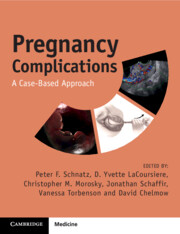Book contents
- Pregnancy Complications
- Pregnancy Complications
- Copyright page
- Contents
- Contributors
- Preface
- Note from the Editor-in-Chief
- Normal Laboratory Values (Conventional Units) []
- Section 1 Antepartum (Early Pregnancy)
- Section 2 Antepartum (Mid-trimester)
- Case 12 A 25-Year-Old with Cervical Insufficiency at 18 Weeks
- Case 13 A 25-Year-Old with an Echogenic Cardiac Focus at 19 Weeks’ Gestation
- Case 14 A 20-Year-Old with Right Lower Quadrant Pain at 15 Weeks’ Gestation
- Case 15 A 40-Year-Old with Decreased Libido at 29 Weeks
- Case 16 A 35-Year-Old with a Left Breast Mass at 35 Weeks
- Case 17 A 25-Year-Old at 14 Weeks’ Gestation with Pelvic Pain and Inability to Void
- Case 18 A 35-Year-Old with Abdominal Cramping and Pelvic Pain at 24 Weeks’ Gestation
- Case 19 Appendicitis Presenting as Nausea, Vomiting, and Abdominal Pain at 16 Weeks
- Section 3 Antepartum (Late Pregnancy)
- Section 4 Antepartum (Medical Complications)
- Section 5 Antepartum (Infectious Complications)
- Section 6 Intrapartum/Delivery
- Section 7 Postpartum
- Section 8 Fetal Complications
- Section 9 Placental Complications
- Section 10 Complications of the Cord, Amnion, and Gravid Uterus
- Section 11 Psychosocial Considerations
- Index
- References
Case 17 - A 25-Year-Old at 14 Weeks’ Gestation with Pelvic Pain and Inability to Void
from Section 2 - Antepartum (Mid-trimester)
Published online by Cambridge University Press: 08 April 2025
- Pregnancy Complications
- Pregnancy Complications
- Copyright page
- Contents
- Contributors
- Preface
- Note from the Editor-in-Chief
- Normal Laboratory Values (Conventional Units) []
- Section 1 Antepartum (Early Pregnancy)
- Section 2 Antepartum (Mid-trimester)
- Case 12 A 25-Year-Old with Cervical Insufficiency at 18 Weeks
- Case 13 A 25-Year-Old with an Echogenic Cardiac Focus at 19 Weeks’ Gestation
- Case 14 A 20-Year-Old with Right Lower Quadrant Pain at 15 Weeks’ Gestation
- Case 15 A 40-Year-Old with Decreased Libido at 29 Weeks
- Case 16 A 35-Year-Old with a Left Breast Mass at 35 Weeks
- Case 17 A 25-Year-Old at 14 Weeks’ Gestation with Pelvic Pain and Inability to Void
- Case 18 A 35-Year-Old with Abdominal Cramping and Pelvic Pain at 24 Weeks’ Gestation
- Case 19 Appendicitis Presenting as Nausea, Vomiting, and Abdominal Pain at 16 Weeks
- Section 3 Antepartum (Late Pregnancy)
- Section 4 Antepartum (Medical Complications)
- Section 5 Antepartum (Infectious Complications)
- Section 6 Intrapartum/Delivery
- Section 7 Postpartum
- Section 8 Fetal Complications
- Section 9 Placental Complications
- Section 10 Complications of the Cord, Amnion, and Gravid Uterus
- Section 11 Psychosocial Considerations
- Index
- References
Summary
Timely diagnosis of uterine incarceration of the gravid uterus is critical for optimal outcomes and to avoid serious maternal morbidity. The most common presenting symptom is urinary retention. Any case of urinary retention in the late first or early second trimester should increase the suspicion for uterine incarceration. The proper diagnosis of uterine incarceration is aided by physical exam that shows the cervix displaced behind the pubic symphysis at a 90° angle, and an ultrasound that shows a sharp curve to the cervix. When diagnosed, the uterus should be reduced. It is reasonable to try conservative methods first. However, if not successful, manual reduction is warranted – sometimes requiring either spinal or general anesthesia. If not diagnosed until the third trimester, there is risk for significant complications, including uterine rupture. Delivery of an incarcerated uterus that has not been reduced by the third trimester should be by a carefully planned cesarean section via a vertical uterine incision. There is high risk of injury to the vagina and bladder as they are typically abnormally stretched superiorly. A preoperative MRI can be helpful to map the distorted anatomy.
- Type
- Chapter
- Information
- Pregnancy ComplicationsA Case-Based Approach, pp. 51 - 53Publisher: Cambridge University PressPrint publication year: 2025

